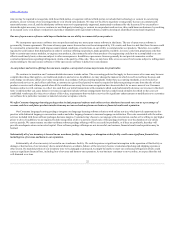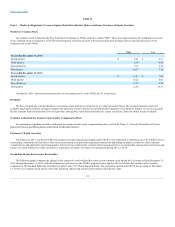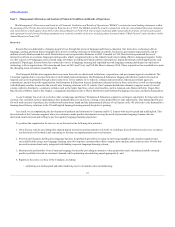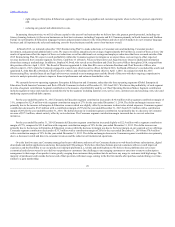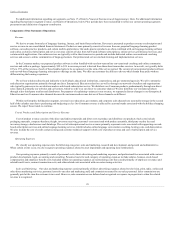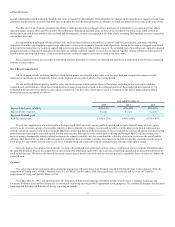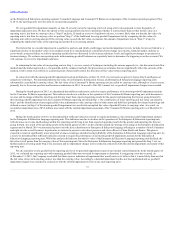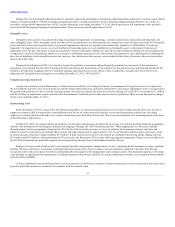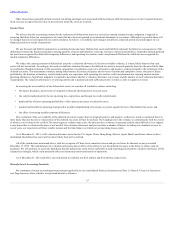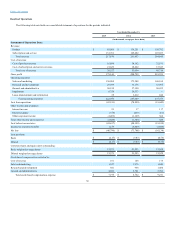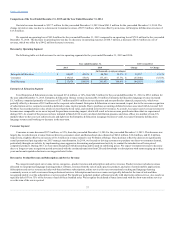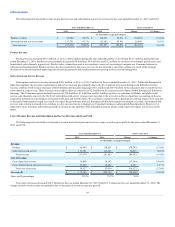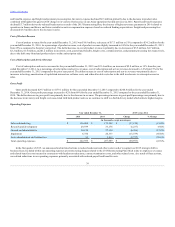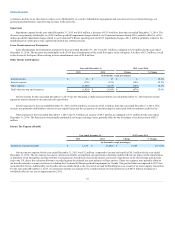Rosetta Stone 2015 Annual Report Download - page 32
Download and view the complete annual report
Please find page 32 of the 2015 Rosetta Stone annual report below. You can navigate through the pages in the report by either clicking on the pages listed below, or by using the keyword search tool below to find specific information within the annual report.
Table of Contents
We identify the units of accounting contained within our sales arrangements and in doing so, we evaluate a variety of factors including whether the
undelivered element(s) have value to the customer on a stand-alone basis or if the undelivered element(s) could be sold by another vendor on a stand-alone
basis.
For multiple element arrangements that contain perpetual software products and related online services, we allocate the total arrangement consideration
to the deliverables based on the existence of vendor-specific objective evidence of fair value ("VSOE"). We generate a substantial portion of consumer
revenue from the CD and digital download formats of the Rosetta Stone language-learning packaged software product which is a multiple-element
arrangement that contains two deliverables: perpetual software, which is delivered at the time of sale, and online services, which is considered an undelivered
software-related element. The online service includes access to conversational coaching services. Because we only sell the perpetual language-learning
software on a stand-alone basis in our homeschool version, we do not have a sufficient concentration of stand-alone sales to establish VSOE for the perpetual
product. Where VSOE of the undelivered online services can be established, arrangement consideration is allocated using the residual method. We determine
VSOE by reference to the range of comparable stand-alone renewal sales of the online service. We review these stand-alone sales on a quarterly basis. VSOE is
established if at least 80% of the stand-alone sales are within a range of plus or minus 15% of a midpoint of the range of prices, consistent with generally
accepted industry practice. Where VSOE of the undelivered online services cannot be established, revenue is deferred and recognized commensurate with the
delivery of the online services.
For non-software multiple element arrangements we allocate revenue to all deliverables based on their relative selling prices. Our non-software multiple
element arrangements primarily occur as sales to our Enterprise & Education customers and also to our Consumer customers. These arrangements can include
a web-based subscription, audio practice tools and professional services or any combination thereof. We do not have a sufficient concentration of stand-alone
sales of the various deliverables noted above to our Enterprise & Education customers, and therefore cannot establish VSOE for each deliverable. Third party
evidence of fair value does not exist for the web-based software subscription services, audio practice products and professional services due to the lack of
interchangeable language-learning products and services within the market. Accordingly, we determine the relative selling price of the web-based
subscription, audio practice tools and professional services deliverables included in our non-software multiple element arrangements using our best estimate
of selling price. We determine our best estimate of selling price based on our internally published price list which includes suggested sales prices for each
deliverable based on the type of client and volume purchased. This price list is derived from past experience and from the expectation of obtaining a
reasonable margin based on our cost of each deliverable.
In the U.S. and Canada, we offer consumers who purchase our packaged software and audio practice products directly from us a 30-day, unconditional,
full money-back refund. We also permit some of our retailers and distributors to return unsold packaged products, subject to certain limitations. We estimate
and establish revenue reserves for returns at the time of sale based on historical return rates, estimated channel inventory levels, the timing of new product
introductions, and other factors.
We distribute products and services both directly to the end customer and indirectly through resellers. Our resellers earn commissions generally
calculated as a fixed percentage of the gross sale to the end customer. We evaluate each of our reseller relationships to determine whether the revenue
recognized from indirect sales should be the gross amount of the contract with the end customer or reduced for the reseller commission. In making this
determination we evaluate a variety of factors including whether we are the primary obligor to the end customer. Revenue is recorded net of taxes.
Revenue for online services and web-based subscriptions is recognized ratably over the term of the service or subscription period, assuming all revenue
recognition criteria have been met. Our CD and digital download formats of Rosetta Stone language-learning products are typically bundled with a short-
term online service where customers are allowed to begin their short-term online services at any point during a registration window, which is up to six months
from the date of purchase from us or an authorized reseller. Short-term online services that are not activated during this registration window are forfeited and
revenue is recognized upon expiry. Revenue from non-refundable upfront fees that are not related to products already delivered or services already performed
is deferred and recognized over the term of the related arrangement because the period over which a customer is expected to benefit from the service that is
included within our subscription arrangements does not extend beyond the contractual period. Accounts receivable and deferred revenue are recorded at the
time a customer enters into a binding subscription agreement.
Software products include sales to end user customers and resellers. In many cases, revenue from sales to resellers is not contingent upon resale of the
software to the end user and is recorded in the same manner as all other product sales. Revenue from the sales of packaged software is recognized as the
products are shipped and title passes and risks of loss have been transferred. For many product sales, these criteria are met at the time the product is shipped.
For some sales to resellers and certain other sales, we defer revenue until the customer receives the product because we legally retain a portion of the risk of
loss on these sales during transit. In other cases where packaged software products are sold to resellers on a consignment basis, revenue is recognized for these
consignment transactions once the end user sale has occurred, assuming the remaining revenue recognition criteria have been met. Cash sales incentives to
resellers are accounted for as a reduction of revenue, unless a
31



